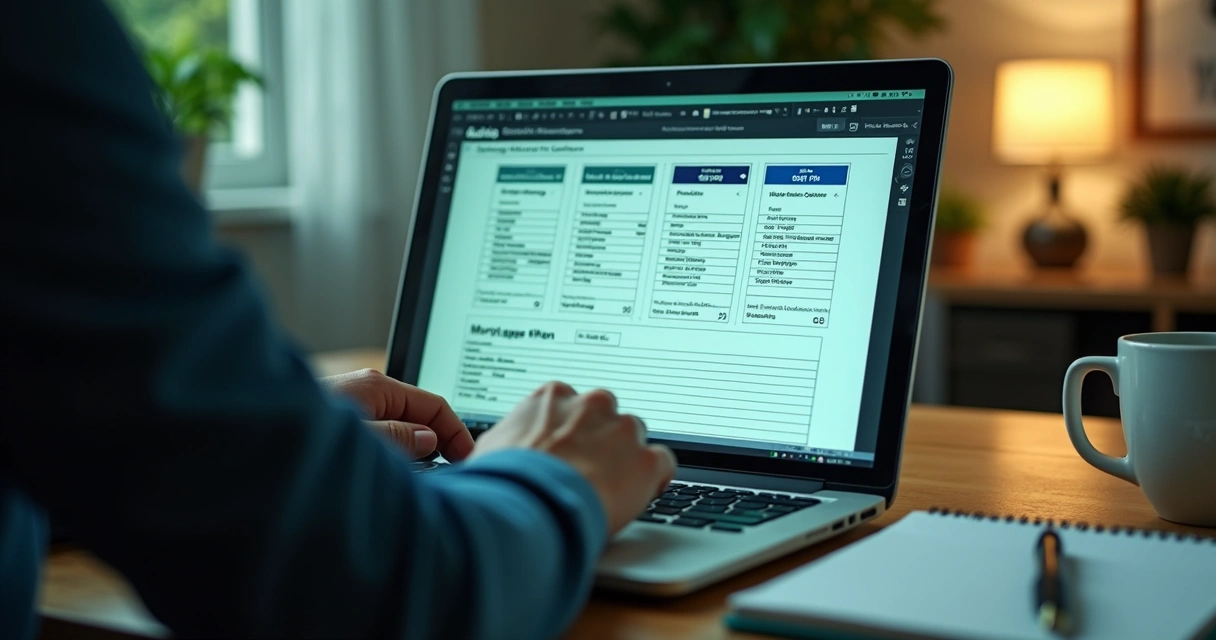If you have ever imagined walking into a home and thinking, “This is it,” you’re not alone. But even before you turn the key, there’s one major part of the journey that can feel a little overwhelming: finding and securing the right mortgage. The steps to apply for a mortgage in the US can seem dense, but breaking them down makes the process much more understandable. Let’s walk through the whole path, patiently, so you feel ready and confident.
1. Get to know your finances
Everyone’s situation is a bit different. Some of us have squeaky-clean credit reports, while others might carry more debt or irregular income. Before you approach anyone about a mortgage, pause and look inward. Lenders will ask—so you might as well know first.
- Credit score: Typically, the higher, the better. Conventional mortgages usually prefer scores above 620, while government-backed loans may consider lower.
- Debt-to-income (DTI) ratio: Add all your monthly debts and divide by your gross income. Most lenders want to see this under 43%.
- Savings: Besides your down payment, you’ll need cash for closing costs and emergency funds.
You don’t have to be perfect, but being prepared puts you ahead. For help understanding your position, resources like the mortgage calculator from Heart Mortgage can give you ballpark numbers quickly.
 2. Understand pre-qualification vs pre-approval
2. Understand pre-qualification vs pre-approval
Many confuse these two, perhaps because they sound so close, but they mean different things. Pre-qualification is a quick assessment—maybe just a few questions about your income and debts. It’s informal, more of a ballpark figure with no promises.
Pre-approval, though, is a statement:
A lender reviews your documents and says, "Yes, you’re likely to get this much."
Getting pre-approved shows sellers you’re serious. It's a big step and requires paperwork, but it means your mortgage is more likely to move forward once you find a home. The team at Heart Mortgage guides buyers through this stage, making it feel much less mysterious.
3. Choose the right mortgage for you
Now, choices. You have to pick between types of loans and rates. Here’s a quick summary:
- Fixed-rate mortgages: The interest rate stays locked for the entire loan term, usually 15 or 30 years. Payments stay steady. In the current environment, rates average around 6.72% for 30-year loans.
- Adjustable-rate mortgages (ARMs): Lower initial rates, then they move up or down after a set period.
- Conventional loans: Not backed by the government. These generally ask for higher credit scores and larger down payments. Read more about these at the Heart Mortgage guide to conventional programs.
- Government-backed mortgages: FHA, VA, and USDA loans have unique requirements and perks. Lower down payments and flexible credit standards are common, especially for first-time buyers or specific groups.
Which suits you? You don’t need to decide immediately—your mortgage specialist (like the team at Heart Mortgage) can adjust the path as you go.
4. Shop around and compare offers
Looking at just one offer is a common mistake—one that costs Americans nearly $11 billion per year in overpayments on mortgages.
Here’s what matters when comparing:
- Interest rates—even a decimal matters.
- Loan Estimate forms: This official document lists your rate, closing costs, taxes, and insurance estimates. Always request a Loan Estimate from each lender.
- Fees: Origination, processing, underwriting—it adds up. Sometimes a lower rate comes with very high upfront costs.
The gap between the best and worst offer is wider than most realize.
This step needs a patient, questioning mindset. Read through common mistakes when applying for mortgages for tips on comparing offers without costly missteps.
 5. Gather your documents
5. Gather your documents
No magic happens without paperwork. Here’s what lenders expect to see (it can feel overwhelming, but the checklist is fairly standard):
- Recent pay stubs (typically two months)
- W-2 forms and/or 1099s (past two years)
- Federal tax returns (past two years)
- Bank statements (recent two months, all pages)
- Photo ID
- Proof of assets (401(k), savings, investments)
- If self-employed: profit/loss statements, 1099s, business tax returns
Staying organized and transparent is key here. Lenders need to trust what they see. If anything’s unclear or fluctuates, be upfront—the process always goes more smoothly.
6. Submit your application
This is when the real action starts. With your pre-approval done, documents in hand, and a home in mind, you’ll officially apply for the loan.
The application includes your personal details, employment info, finances, and property details. Many lenders now allow online submission, but you can always ask for phone or in-person help (a feature Heart Mortgage provides, by the way, if you feel more comfortable that way).
7. Consider locking in your rate
Mortgage rates can change daily. If you find a good rate on your chosen mortgage, you can request a “rate lock”—which means your rate is reserved for a certain period, sometimes 30-60 days. This can help you avoid last-minute market swings. With average rates hovering between 6% and 7% for much of 2025, the ability to secure a good rate is comforting for many buyers (market analysis shows rates are expected to remain high for now).
There’s a balance here: If you lock in too early, the process might extend past your lock period; too late, and rates could rise. Talk openly with your mortgage advisor about when to pull the trigger.
8. Appraisal and underwriting
With your application submitted and documents sorted, the mortgage company will send an appraiser to value the property. This protects both you and the lender from overpaying. Sometimes the appraisal comes in lower than the sale price, and you might need to renegotiate or increase your down payment; sometimes, it matches perfectly.
While all this is happening, your file enters underwriting. Underwriters check every piece of your story: your finances, the property, even your intent to stay there. If anything pops up—say, a late payment or unexpected deposit—they might ask for more documents or explanations.
 9. Final approval and closing disclosure
9. Final approval and closing disclosure
Here comes the home stretch. When your mortgage is approved, you’ll get a Closing Disclosure at least three business days before the finish line. This document summarizes the final terms, monthly payment, interest rate, and all costs due at closing. Compare closely to your last Loan Estimate—sometimes small numbers sneak in, and now’s your chance to ask questions.
Your real estate agent can guide you through this stage. If you haven’t worked with one yet, consider reaching out. They help tie together the details and keep everyone moving.
10. Closing day and moving in
On the day of closing, expect to review and sign several documents. This part may feel formal and a little intimidating, but it’s when the transfer becomes real. You’ll pay your closing costs—typically 2%–5% of the loan amount—which include lender fees, appraisal, title insurance, prepaid taxes, and more.
Your agent and lender will walk through the numbers again. Once everything is signed, you get your keys. That’s it.
The moment you’ve waited for: the house is yours.
The process takes time and persistence. In many states, getting to this point has been more challenging with higher rates and low inventory—the so-called “lock-in effect” discourages some sellers from moving, making homes stay scarce. Despite these bumps, the housing market has stayed resilient, with inventory slowly rising especially in large metro areas.
Bonus: useful resources
- Mortgage tips and news—helpful for keeping track of changing rules and trends
- A complete guide to mortgage loans in the US—perfect if you like a deep dive
Whether you're a first-timer or a seasoned buyer, clarity and transparency are key. That's why Heart Mortgage puts such an emphasis on honest guidance every step of the way, from comparing loan types to offering flexible ways to stay in touch.
Conclusion: your next step on the journey
You may feel the road is long, but remember that every homebuyer goes through these same stages—with their own doubts and little detours. You don’t have to do it alone. The Heart Mortgage team helps buyers of all backgrounds find the right solution, even when hurdles seem high or the process feels confusing. If you’re ready to see numbers, compare options, or just want someone to explain a tricky bit of paperwork, reach out. Your home is waiting—and Heart Mortgage is ready to make the journey as straightforward as possible.
Frequently asked questions
What are the basic steps to get a mortgage?
The basics involve checking your credit and finances, choosing the best loan type for your needs, getting pre-approved, comparing rates and offers from multiple lenders, gathering your documents (like tax returns and pay stubs), submitting your application, locking in your interest rate, having the property appraised, reviewing the final disclosure, and signing on closing day. The process above gives a fuller walkthrough for each part.
How long does the mortgage application process take?
From pre-approval to closing, it usually takes 30 to 45 days. Sometimes it drags on if there are delays with paperwork, appraisals, or underwriting. If your situation is complex (such as self-employment or buying during a high-traffic season), expect it to take a bit longer.
What documents do I need to apply for a mortgage?
Commonly requested documents include recent pay stubs, W-2s or 1099s, two years of federal tax returns, recent bank statements, photo ID, and statements from investment or retirement accounts. If self-employed, additional business paperwork is required. It helps to keep everything organized and ready to share.
How can I improve my chances of approval?
Check your credit score and pay off debts if you can. Don’t take on new credit or large purchases before applying. Save for a larger down payment. Stay transparent about your finances—lenders prefer straightforward, documented situations. And always compare multiple lenders to find the right fit for your profile.
Is a pre-approval required for a mortgage?
No, but it is highly recommended. A pre-approval shows sellers and agents that you’re a serious buyer and can move forward quickly. Also, it gives you a clearer idea of your budget and what you can realistically afford, which makes your search smoother.





